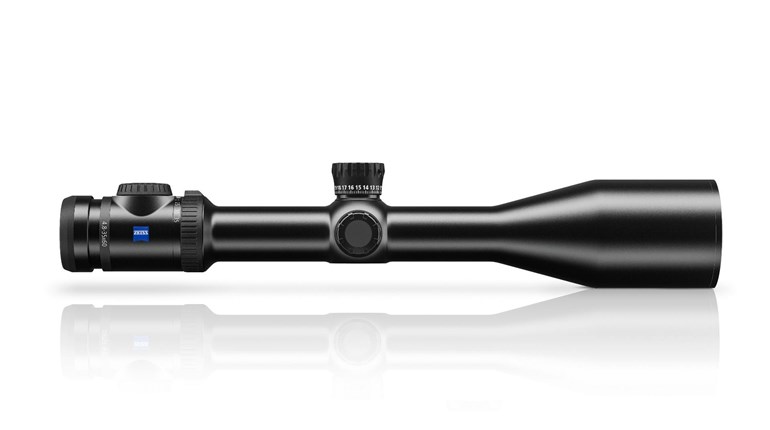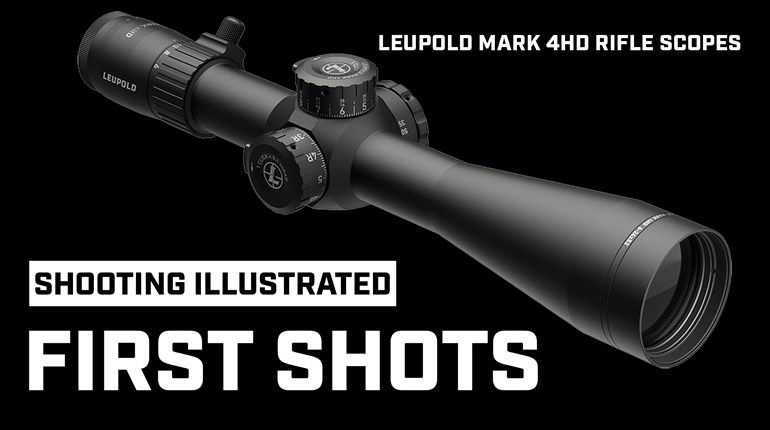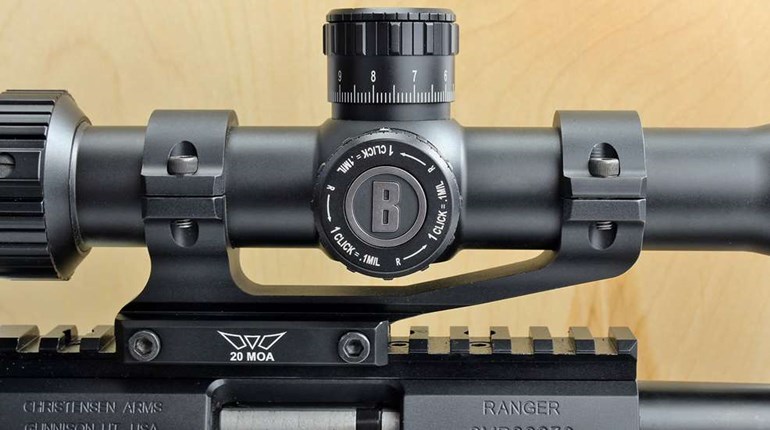
You can now buy just about any permutation of riflescope never imagined just 20 years ago. Want a 6.5X zoom range? You’ve got it. Want a main tube 34mm in diameter? No problem. How about a 56mm objective, side focus, an illuminated ballistic-drop-compensating reticle and custom-dial turrets that’ll take you out to 1,250 yards? Show me the money.
With a scope like that, the only other things you need are two grown men and a boy to carry it and an engineer to operate it. Or you can just mount a 3X-9X-40mm Bushnell Elite 3500 and go hunting.
A 3X-9X-40mm riflescope is the optical equivalent of the .30-06. It’s not flashy, not cool, not tactical and not even current. It’s just deadly—and versatile, lightweight, bright, sharp and eminently practical.
Bushnell seems to have five lines of hunting scopes with the Elite advertised as second from the top, suggesting its quality is pretty high. But within the Elite line are the 6500, 4500 and 3500 models. The difference among them appears to be only zoom range at 6.5X, 4X and 3X, respectively. Other than that, the “basic” Elite 3500 is apparently built with the same ingredients and features as the more expensive models, including argon gas purging. Argon’s benefit over nitrogen is larger molecule size, which should translate to a longer performance life before the gas leaks from aging seals.
Don’t worry about adequate anti-reflection coatings on the Elite 3500 scopes. Every air-to-glass surface is fully multi-coated with Bushnell’s Ultra Wide Band coating process, which the company says includes 60 layers on each lens. I believe that means 30 on each side. I assume Ultra Wide Band refers to the colors humans can see within the electromagnetic spectrum, roughly from the 780 nanometer reds to the 390 nanometer blues. RainGuard HD exterior lens coatings minimize fogging by making surfaces so slick that droplets coalesce into larger drops that roll off the lens.
The upshot is a claimed 91 percent light transmission. That compares favorably to the 94 percent to 95 percent claimed for a very few scopes. Perhaps more significantly, it matches transmission claims for many top-end Euro scopes costing two to four times as much. How accurate any of these claims are remains debatable. Such figures are good starting points best tested visually by comparing the view with other scopes.
My wife and I did that with a Swarovski 3X-10X-42mm and Zeiss Victory 2.5X-10X-42mm. She quickly picked both as giving her a quicker, “clearer” view but couldn’t really say either was appreciably brighter than the Bushnell 3X-9X-40mm.
At dusk the Elite 3500 began to lag behind the high-end models, appearing to be about a stop dimmer. Still, while looking into a shadowed declivity under a boulder 85 yards away at 9X with the Bushnell, I was able to see the same lichen the other scopes revealed. Some 40 minutes after sundown, the Elite’s plex reticle showed clearly against the darkest boulders and shadowed trees. I wouldn’t hesitate to hunt deer with this scope during any legal shooting hours.
With each scope set at 8X, I tested flare control by looking toward the sun about an hour before it set, keeping it just out of view, then sliding down to peer into deep shadows where I could clearly see detail and richly saturated colors on tree limbs and leaves. I detected virtually no flare in any of the scopes, which is high praise for the coatings on the Elite 3500.
The 1-inch main tube widens to a 47.5mm objective bell that houses a 40mm objective lens. My measurement of the objective lens revealed a full 40mm of its diameter was exposed and available for admitting light. Divided by 9X, that should yield an exit pupil of 4.4mm. Measured physically with a caliper, exit pupil came to roughly 4.7mm, suggesting top magnification is just a bit below 9X. Bushnell claims eye relief at 3.3 inches, but I measured it as 3 inches at 8X with a good inch of forgiveness in either direction.
In keeping with the theme of basic, clean simplicity, the 3500 looks and feels sleek, solid and minimalist, just what I like in a general-purpose hunting scope. The diopter is adjusted by turning the very end of the eyepiece, which is stiff enough to hold where set. The aluminum power wheel turns smoothly and silently with consistent tension. A knurled surface with raised ribs every half inch or so provides a solid grip, and a half turn runs from 3X to 9X.
Low-profile aluminum turret caps are lightly knurled and seat against rubber gaskets. They twist off easily and smoothly to reveal finger-adjustable dials with 1/4 MOA adjustments that click into place audibly. Rainy weather forced me to test adjustment accuracy mechanically. I mounted the scope on a Merkel K1 rifle, fixed a Simmons bore collimator in the barrel and zeroed the scope on the center of the collimator’s grid. I then began dialing to see where that would take me on the grid of MOA squares. Regardless how many clicks I dialed and in what direction, returning the same number brought me back to center, every time. Turret accuracy appeared to be spot on for a
1 MOA move, but a 2 MOA move appeared to push the reticle about 1/4 MOA too far and a
3 MOA move appeared to overrun by 1/3 MOA. Since this scope is not designed as a long-range, turret-dialing ballistic system, I can live with this—especially since I wasn’t able to actually test fire for group centers after these adjustments.
With the reticle centered on the target grid, I watched closely while dialing power up and down the scale. I detected no change in the reticle’s position throughout the magnification range.
This scope is fitted with a Multi-X, dual-thickness reticle, which is ideal for any big-game hunter shooting a modern, bottlenecked cartridge out to 300 yards, perhaps 400 yards using the maximum point blank range system. That said, it can be purchased with Bushnell’s DOA 600 reticle, which offers multiple aiming bars plus Rack Bracket hash marks on the horizontal bars for subtending the spread between a deer’s ear tips.
All in all, a pragmatic hunter should find the Elite 3500 more than good enough to “ride the river with.” At typical street prices, and with Bushnell’s limited lifetime warranty and one-year money-back guarantee, the Elite 3500 could be considered a best buy, too.
Technical Specifications:
• Type: variable-power riflescope
• Magnification: 2X-6X (handgun), 2X-7X, 3X-9X (tested), 4X-12X
• Objective Lens Diameter: 32mm, 40mm (tested), 50mm
• Eye Relief: 3.3"
• Exit Pupil: 13.3mm (3X), 4.4mm (9X)
• Field of View @ 100 Yds: 33.8' (3X), 11.5' (9X)
• Reticle: second focal plane; Multi-X (tested), DOA 600 CF
• Adjustments: .25 MOA
• Coatings: fully multi-coated; Ultra Wide Band, RainGuard HD
• Dimensions: tube diameter 1"; length 12.6"; weight 13 ozs.
• Construction: one-piece, anodized aluminum tube; argon-filled, waterproof, fog-proof
• MSRP: $299.99 (3X-9X-40mm)




































